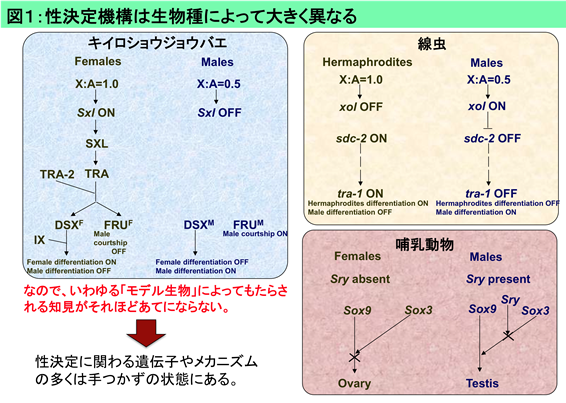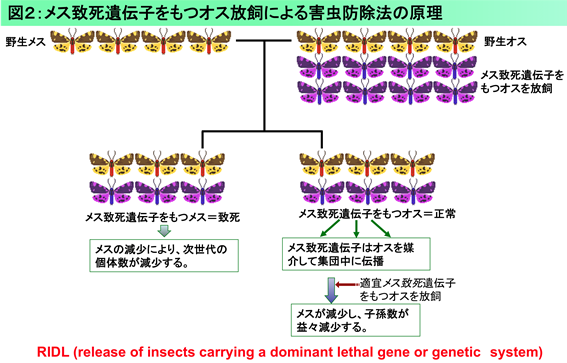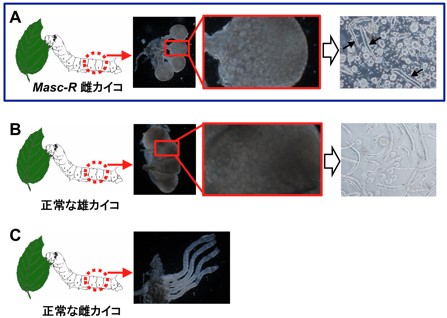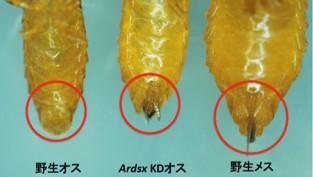We were chosen as the research project team.
Professor Masataka Suzuki of our laboratory has been appointed to the research project team for “Sex Spectrum”.
The aim of this project is to clarify the mechanism of sex determination and sex differentiation. We are trying to clarify the mechanism by which Csd, a sex-determining gene in bees, determines sex by allele differences.
For more details, please refer to the following website.
Insect group (Masataka Suzuki)
― Studies on the diversity of insect sex-determination mechanisms and insect-specific functions
We can say that “the earth is a planet of insects”. This is because insects account for 54% of all plants and animals on Earth. The main reason for the prosperity of insects is their high adaptability. From dormancy to withstand unsuitable environments, metamorphosis to produce dynamic functional changes, and diverse reproductive modes, their adaptive capacity is far beyond human imagination. In particular, our main research theme is to focus on the various modes of sex determination and sex differentiation in insects. Insects differ from vertebrates in that they do not possess sex hormones, and there is a wide range of sex determination patterns among insect species, many of which remain unresolved. Since sexual differentiation is closely related to reproduction, understanding the sex-determination mechanisms of various insects will make it possible to control insect reproduction, which can be applied to pest control methods. With this in mind, we are conducting research to expand our understanding of the mechanisms of sex determination, sex differentiation, and germ cell differentiation in insects, focusing on the silkworm as a model insect, with a view to applying these mechanisms to pest control methods. In addition, the structural and functional basis of insects’ advanced adaptive capacity is thought to contain elements that can be applied as biological resources. Therefore, in this research field, we are also planning to pursue the functional characteristics of insects in order to develop new biological resources.
For more information on sex determination in insects, please see this review.

The Mystery of the Mechanism of Sex Determination in Insects – What is the Switch by Splicing?
Biological Sciences Genetics, September 2016, Published.
Why sex determination research?
There are three reasons.
1) Because it is a high-impact study
Why is sex determination research so impactful? This is because the genes found in sex determination studies are often novel genes, and the mechanisms by which they determine sex are often unexpected. Deciding whether to be a male or a female is a natural phenomenon that occurs in many organisms, but the molecular mechanism of this phenomenon differs greatly among species (Fig. 1). This unexpectedness has had an impact on the study of sex determination.

2) Because it is niche research
Finding a niche is the key to success, not only in the field of business, but also in the field of science. Sex determination mechanisms vary greatly among species. Many of the genes and mechanisms involved in sex determination remain untouched. And yet, all of them are involved in the universal phenomenon of determining whether an organism is male or female. All of this makes sex determination research an excellent niche research field.
(3) Because it is research that can lead to applications
It is also important to maintain the motivation to do research because you feel that your research will be useful to the world. Abnormalities in sex-determining genes can cause either male or female lethality or infertility. Moreover, sex-determined genes show high species specificity. This means that sex-determined genes are excellent targets for pesticides. Overseas, a method to exterminate target pests by releasing insects that induce female lethality by modifying sex-determining genes (RIDL: Release of Insects carrying a Dominant Lethal gene) is in the experimental stage (Fig. 2). We are also working on the development of a method to induce lethality and infertility by artificially controlling the expression of sex-determining genes.

About our current research.
・For 3rd year undergraduate students and younger, general public
・For 4th year undergraduate students, Master’s students and new students
Research: (1) Search for sex-determining genes
Although sex determination in insects has been studied for a long time, only a few insects, such as Drosophila melanogaster, have been shown to have sex-determining genes. In our laboratory, we are using advanced genetic methods such as whole genome sequencing and transcriptome analysis to identify sex-determining genes.
To prove that the genes are actually involved in sex determination, we conduct functional analysis of the genes by genetic recombination, genome editing, and RNAi knockdown.
So far, our team has succeeded in identifying the female-determining gene Fem and the male-determining gene Masc in the silkworm (Bombyx mori) for the first time in the world. We are also working day and night to identify sex-determining genes in several other insect species.

Fig. 1. Masc, an oogenesis gene found in the silkworm (Bombyx mori), causes oogenesis in the ovary when activated in females.

Fig. 2. Knockdown of doublesexM in the male reproductive organs of Apis mellifera (Athalia rosae) results in feminization of male reproductive organs and formation of oviducts.
Research: (2) Elucidation of the regulatory mechanism of sex determination
Although sex-determining genes have been identified in several species, the detailed function of these genes remains largely unexplored. In our laboratory, we are studying the molecular mechanisms of sex determination by analyzing genome-wide protein-gene interactions and gene transfer.
We identify target genes and sequences of sex-determining genes by RNA-seq, ChIP-seq, and RIP-seq, and introduce substituted genes and genomic regions into cultured insect cells and organisms such as silkworm BmN cells to prove that the sequences are actually important for sex determination.

Fig. 3. TRA protein, a feminized gene product of the housefly (Musca domestica), regulates the splicing of pre-mRNA encoding itself.
We introduced the fruit fly tra gene into BmN cells and found that the TRA protein recognizes a trinucleotide (GEG) in the TraCAM domain region of the mRNA.

Fig. 4. Reporter assay showing the expression of the female germplasm gene lozange in Drosophila (Drosophila melanogaster) with green fluorescence of GFP.
It is known to be regulated by the doublesexF feminization gene. In the wild type genome, the gene is expressed (images B and D), but when the predicted binding region (DBS) of doublesexF is mutated, the expression is lost (images F and H). In contrast, no change occurs in males (images C, E, G, and I).

